Dino Toppmöller’s arrival at Eintracht Frankfurt brings a fresh tactical vision that has already begun reshaping the team’s approach on the field. Known for his detailed planning and innovative strategies, Toppmöller has crafted a style that combines disciplined defensive structures with fluid attacking movements. This analysis dives into the tactical principles he’s introduced, highlighting the formations, pressing tactics, and key player roles that define Frankfurt’s play under his guidance. Through Toppmöller’s methods, Eintracht Frankfurt is emerging as a team that can adapt dynamically, maintain possession, and pressure opponents in new, effective ways.
Build-up
Low Build-up
In the low build-up, Toppmöller usually sets his team up in a 1-4-2-2-2 formation, with a back four, two holding midfielders, two attacking midfielders, and two strikers playing up front.
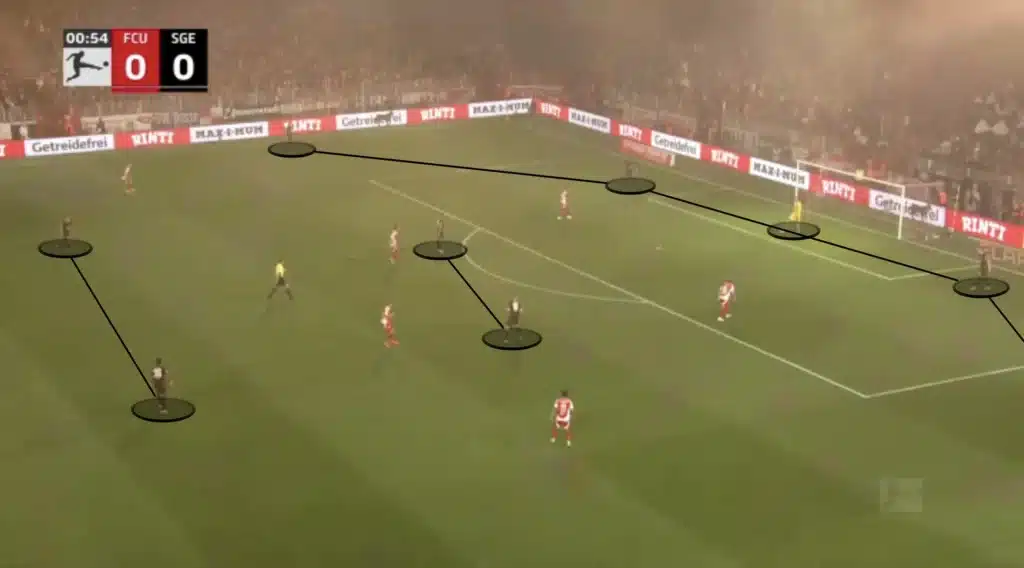
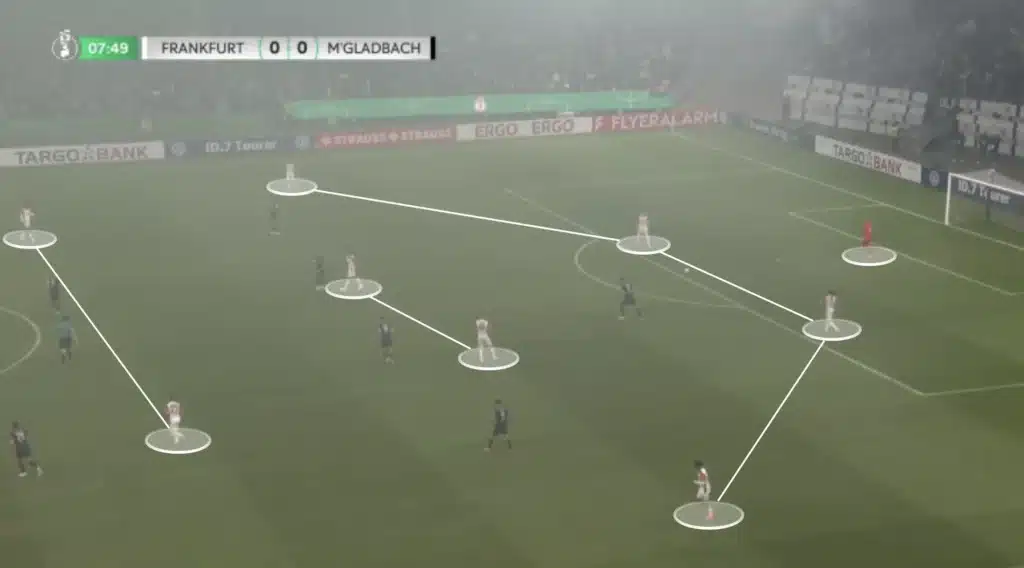
Eintracht Frankfurt’s use of the 1-4-2-2-2 formation when building out from the back provides a structured yet flexible approach that creates a numerical advantage in the middle. With this setup, Frankfurt positions two central midfielders just ahead of the backline, offering secure passing options and helping to control the tempo from deep. In front of these midfielders, two attacking midfielders (or wingers) tuck inside, creating an additional layer in the midfield. The central players can quickly link up to beat the initial line of pressure and progress the ball higher up the pitch, where the forwards can be more directly involved.
Additionally, this compact setup lets Frankfurt be more direct in the low build-up and quickly go to attack. In their 1-4-2-2-2 structure, they often win long balls from the goalkeeper by positioning their attacking midfielders close to the strikers to contest for second balls. When they win the second ball, the strikers and attacking midfielders will immediately attack the opposition’s defense, mainly targeting the space behind the backline.
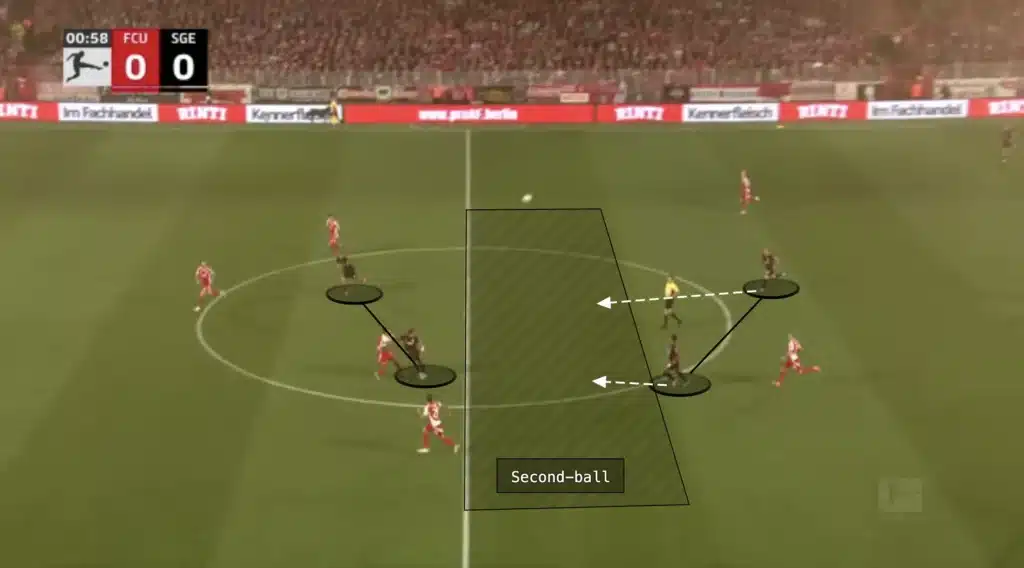
High Build-up
In the high build-up, Frankfurt usually use a very dynamic and fluid 1-2-4-4 structure, with the fullbacks pushing up next to the holding midfielders.
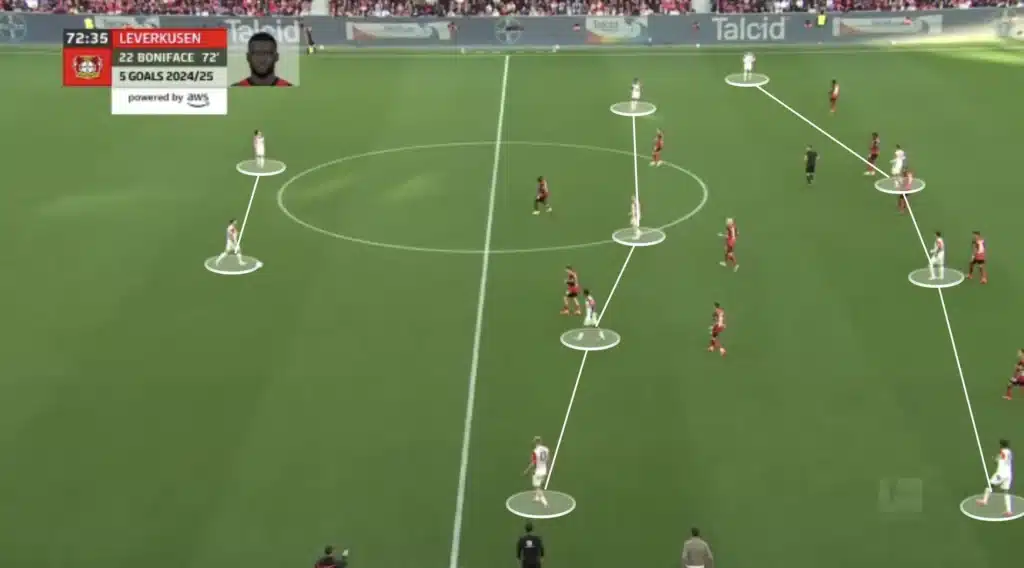
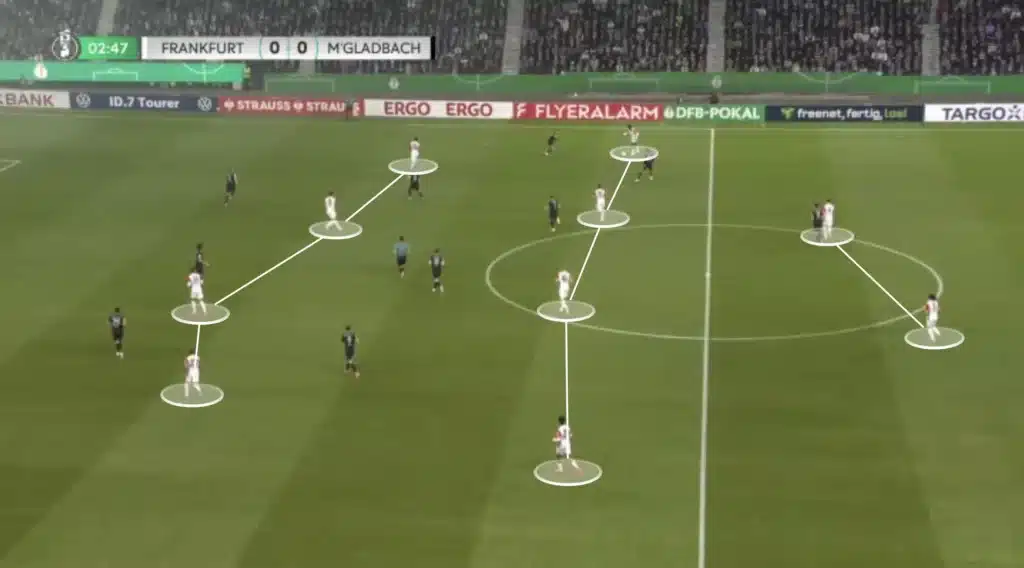
One of Frankfurt’s wide players, the winger or fullback, will often invert during the build-up phase to create a stronger presence in the midfield. Different spaces open up depending on who inverts, which the Frankfurt players are good at identifying and taking advantage of.
If the wingers invert to occupy central spaces, the opposition’s fullbacks usually follow, leaving space for Frankfurt’s fullbacks to push up into. A Frankfurt center-back or midfielder will often play a long ball to the running fullback into this space, allowing the fullback to take the ball forward to create a crossing opportunity.
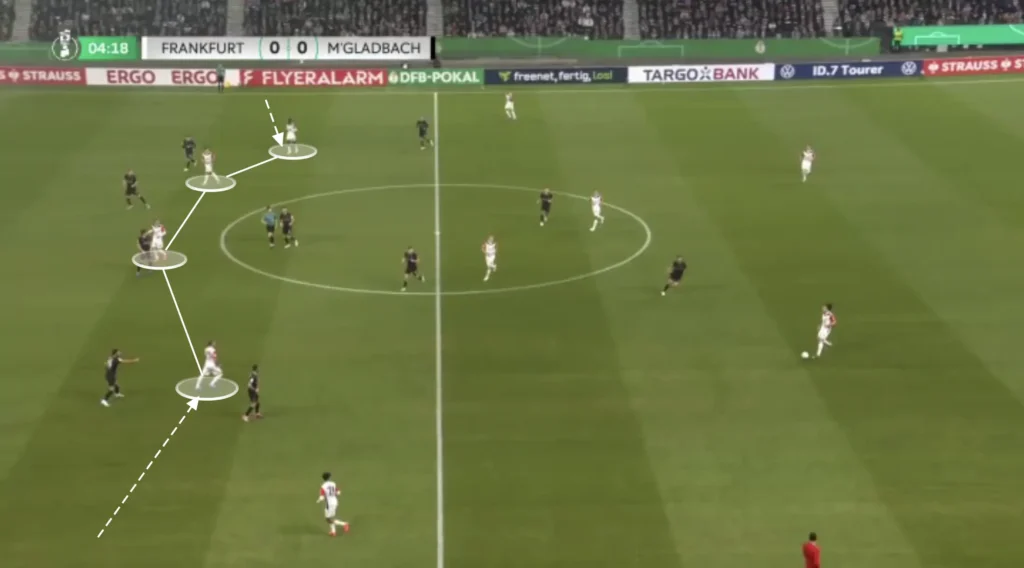
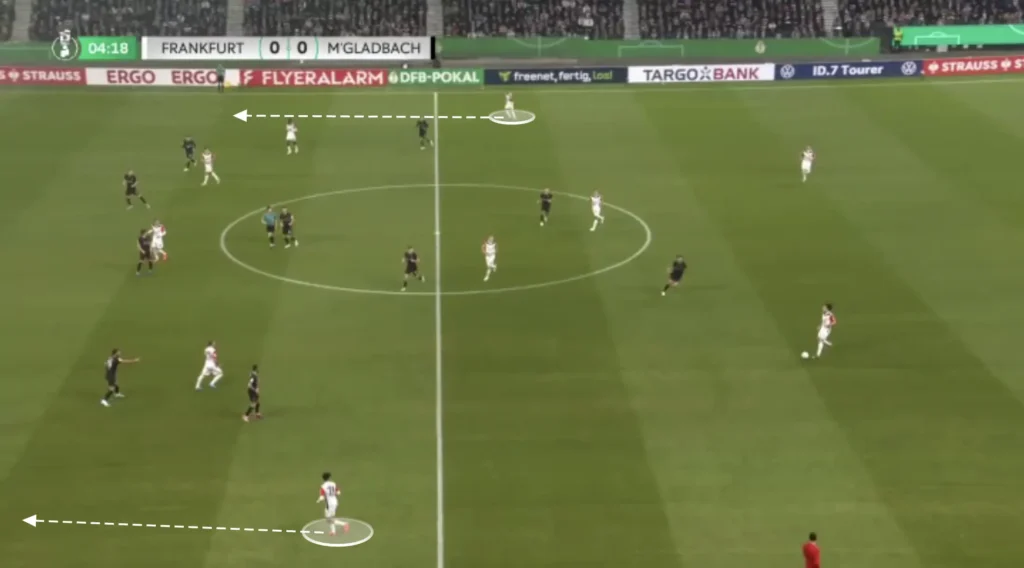
When the fullbacks invert, on the other hand, the opposition wingers usually come inside to cover the run, which opens the passing lane from the center-back to the winger. The center-back can play the ball to the winger, who can attack the opposition fullback and combine with the attacking midfielder to create a 2v1 situation.
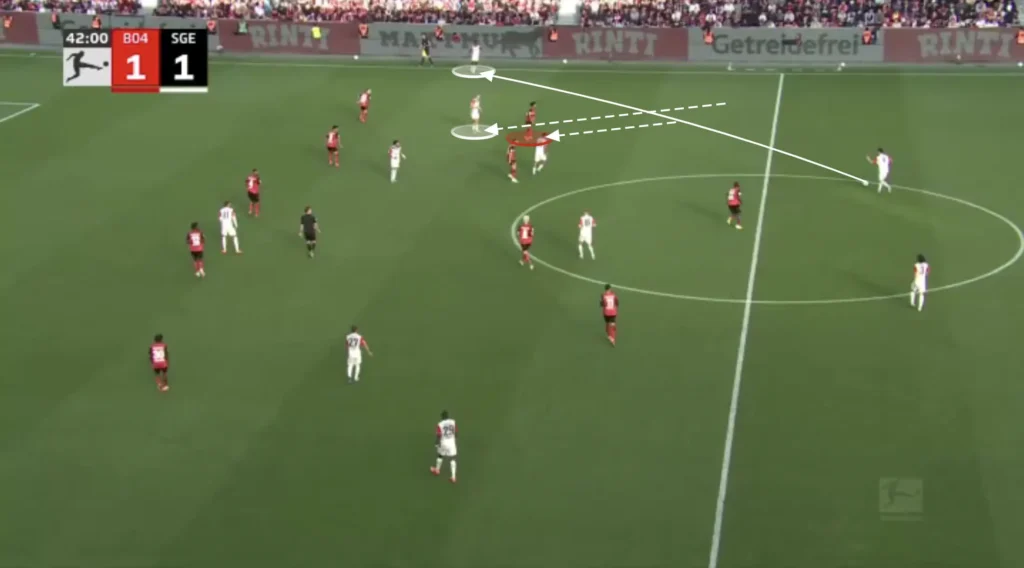
This adaptable setup keeps the opponent guessing, as Frankfurt’s players move seamlessly between supporting roles and creating decisive opportunities, making the team difficult to contain and consistently threatening in the final third.
Rotations and Fluidity
The Frankfurt players constantly rotate during the build-up. The team adopts a dynamic approach, shifting between formations to create numerical advantages and exploit spaces. Toppmöller’s focus is always to get the players into their best positions, where they can make the most out of their individual skills. He emphasizes versatility, with players interchanging positions seamlessly to maintain possession and disrupt the opposition’s defensive structure. This flexibility creates numerical superiorities in different areas, allowing Frankfurt to bypass the opposition’s press while maintaining control.
Frankfurt will, for example, often push a holding midfielder up into the forward line. This shift creates a 1-2-3-5 formation, giving Frankfurt more players higher up who can attack the opposition’s defensive line.
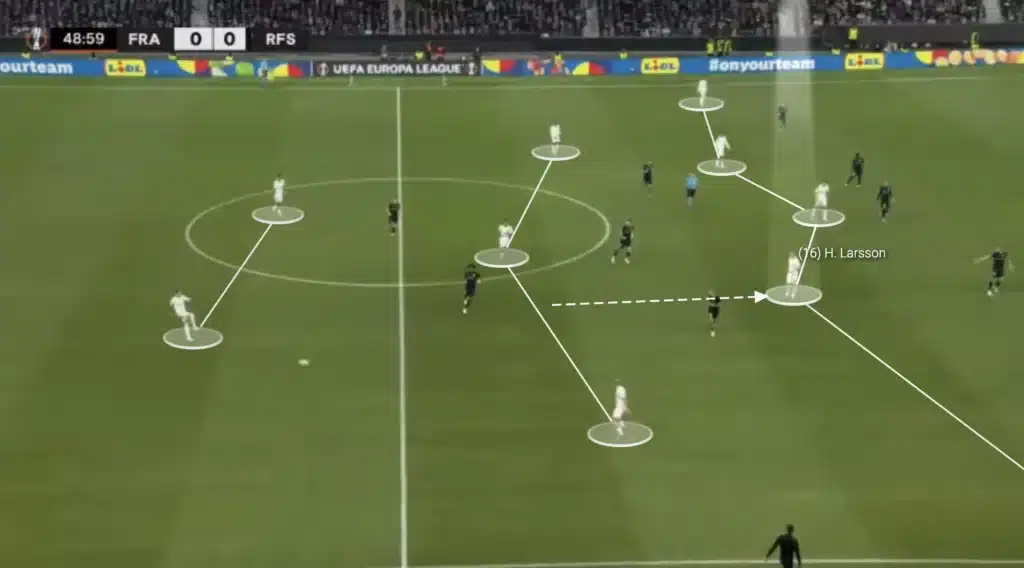
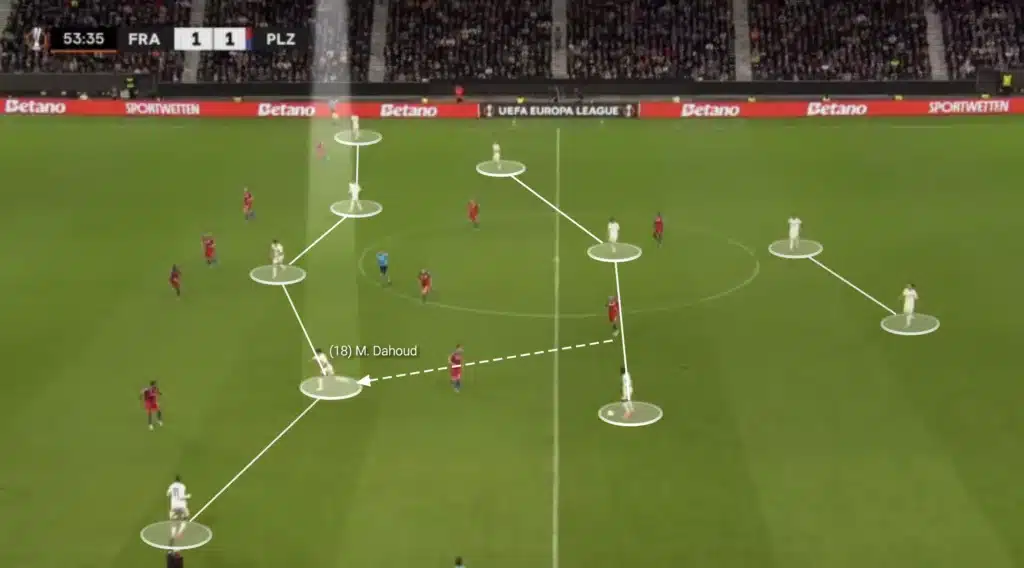
Another common Frankfurt rotation is to come in with one of the fullbacks and push the other one up. This shift creates a back three, allowing them to maintain defensive stability while gaining more control in possession.
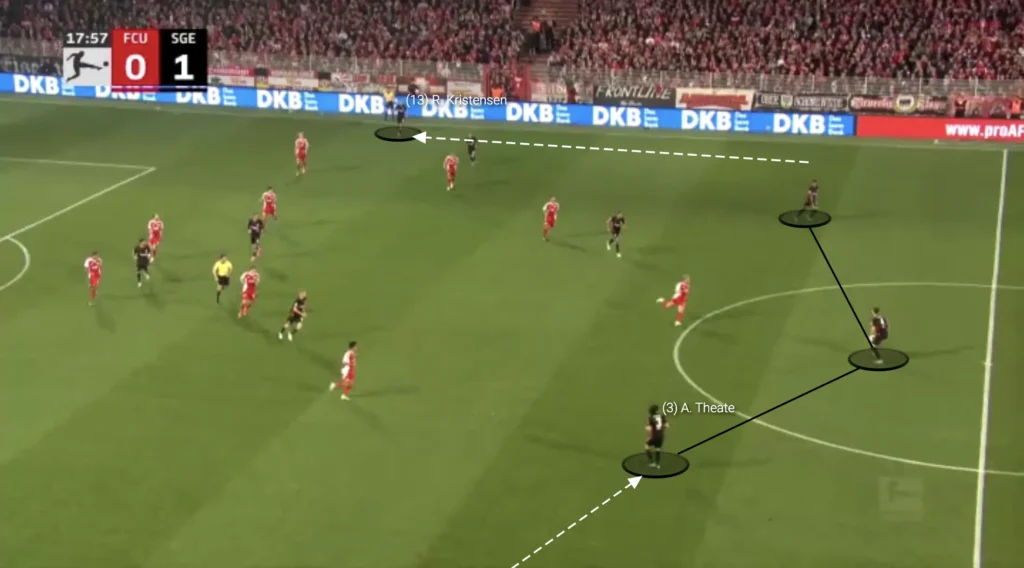
By doing this, Frankfurt not only widen the field but also open up different angles for passing, making it easier to beat the opposition’s press. It also gives them more options in progressing the ball up the field and disrupts the opponent’s pressing structure, helping them maintain fluidity in their play.
While it demands a lot of technical and tactical skills from the players, this fluidity has created new dynamics for Frankfurt’s attacking style, offering new solutions and ways of beating the opposition’s press. It enhances their ability to control the game while opening up opportunities for incisive passes and creative plays.
Inverting the Far-Side Fullback
Frankfurt’s use of the far-side fullback is a distinctive feature in their tactical setup, especially when the ball is on the opposite flank. In these situations, the far-side fullback tucks into the midfield, adding numerical support and enhancing the team’s shape. This movement helps Frankfurt maintain balance, preventing large gaps from opening up on the far side, while also preparing for any potential counterattacks. By drifting inward, the far-side fullback offers an additional passing option for circulating the ball and can act as a safety valve in case of a quick transition by the opposing team. This positioning also allows Frankfurt to maintain a compact structure, ready to press immediately if possession is lost, and keeps them poised to recycle the ball back into play smoothly, supporting their fast-paced, attacking style.
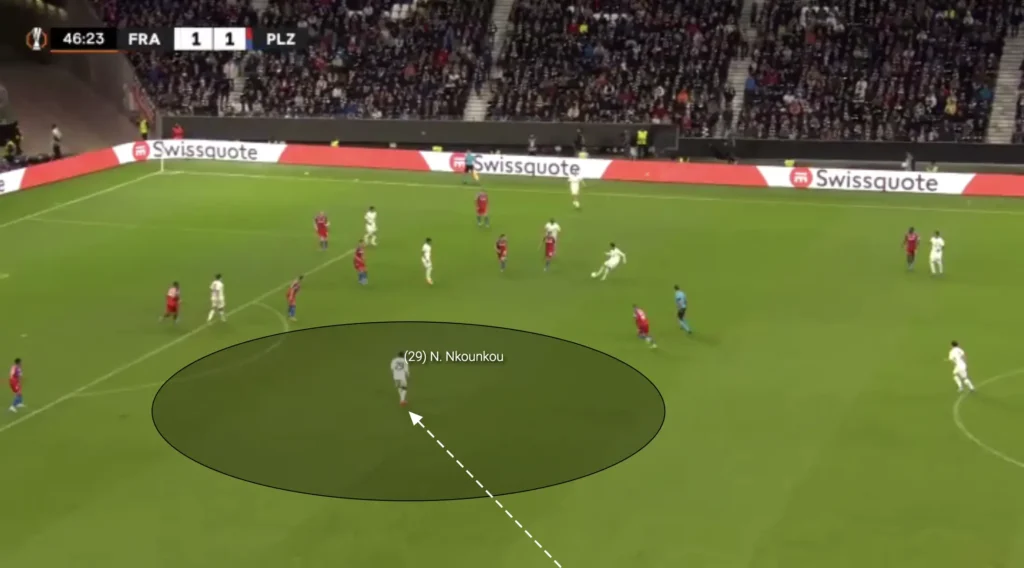
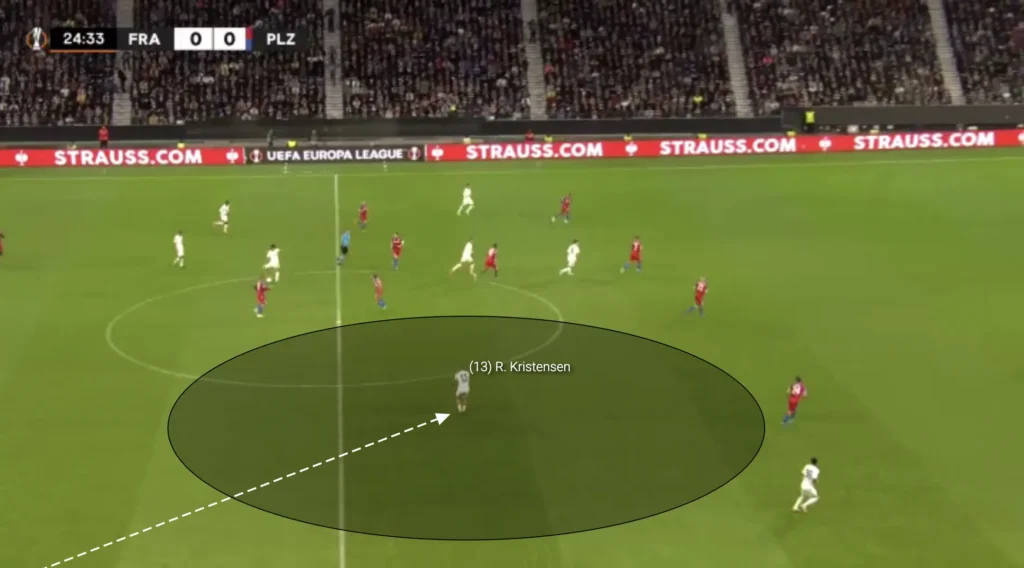
Additionally, Frankfurt frequently utilizes their fullbacks to switch the play, exploiting the open spaces on the weak-side(the other side from where the ball is). When they seek to progress the ball, they often shift it across the pitch to the fullback on the far side. This switch of play helps them bypass congested central areas, allowing the fullback to receive the ball in more space. From this position, the fullback can then advance the ball into the final third, link up with midfielders, or look for forward runs from wingers and strikers. By progressing the ball through the fullback, Frankfurt can maintain their attacking momentum, pulling defenders out of position and creating gaps for quick combination play.
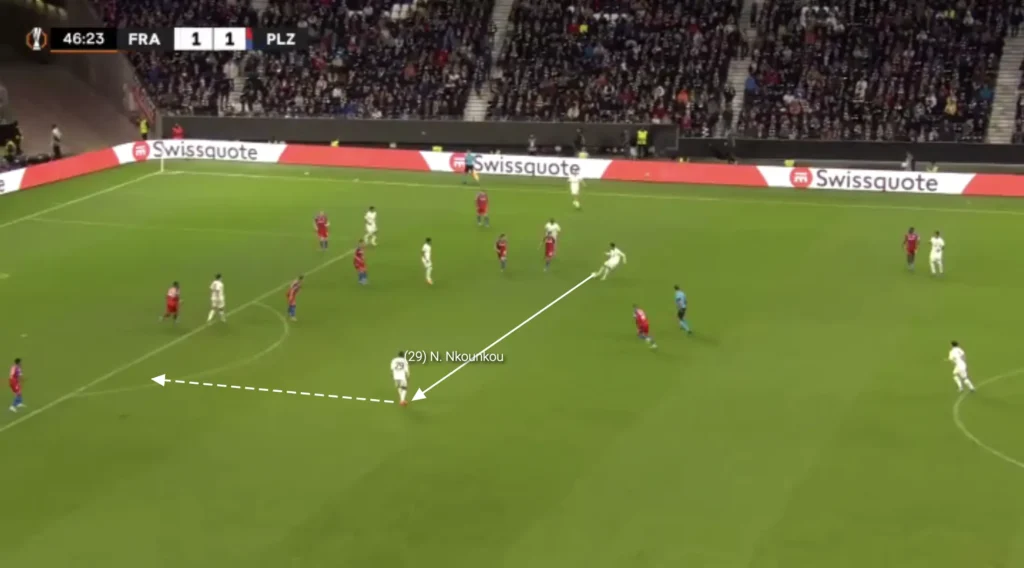
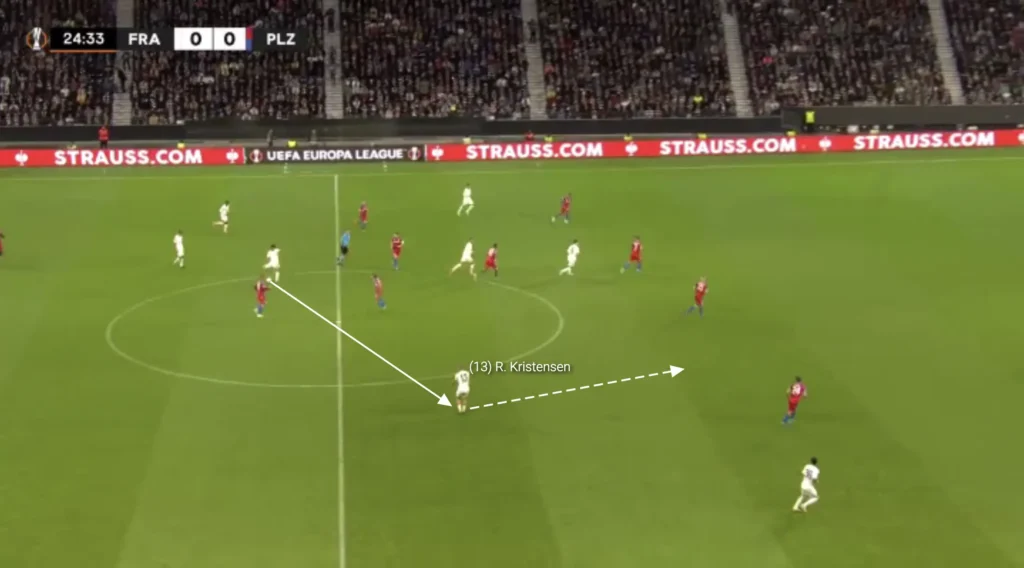
High Backline
Another massive aspect of Toppmöller’s high build-up is to have the defenders high up and close to the center. This helps in the counterpress because they get closer to the midfield. Having more players close to the center who can win the ball back makes it difficult for the opposition to do anything when they win possession. Furthermore, the high backline shortens the distance between players, shortening the time and length of the passes and preventing the opposition from pushing up their defense.
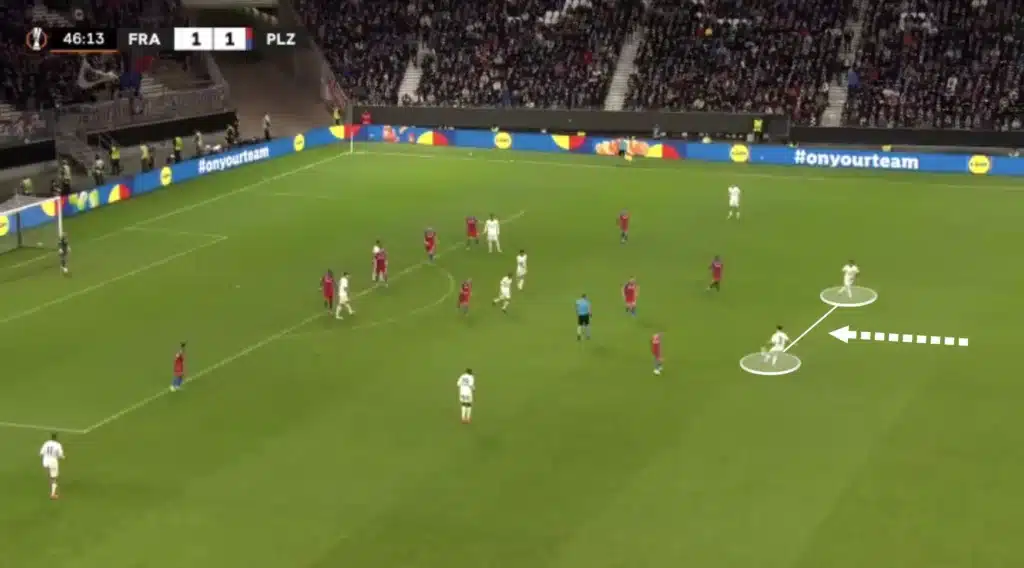
Finding the Pockets
Toppmöller’s players always try to find the attackers in the pockets. These “pockets” refer to the spaces between the opposition’s defensive and midfield lines, where the strikers or wingers can drop into and receive the ball.
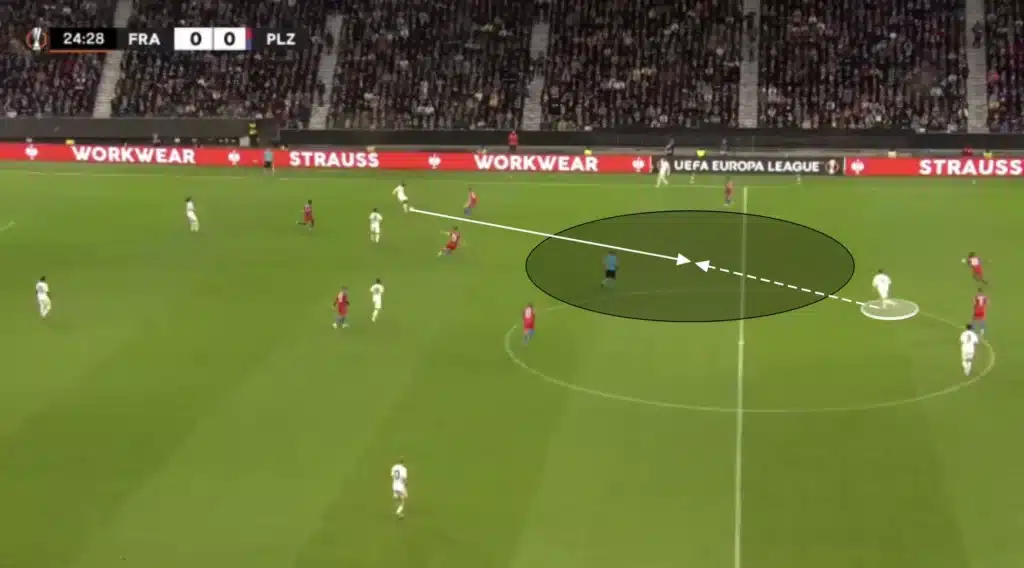
By positioning themselves intelligently in these pockets, the Frankfurt attackers can turn quickly and face the opposition’s goal, creating opportunities for through balls, driving runs, or direct shots. This positioning forces the opposition to make difficult decisions. If an opposition defender steps up and closes down the Frankfurt player, he potentially leaves space behind. However, if he stays back, he allows the attacker time on the ball. The Frankfurt defenders and holding midfielders will look for straight passes, breaking the opposition lines and finding the dropping attackers who can turn and drive at the defense.
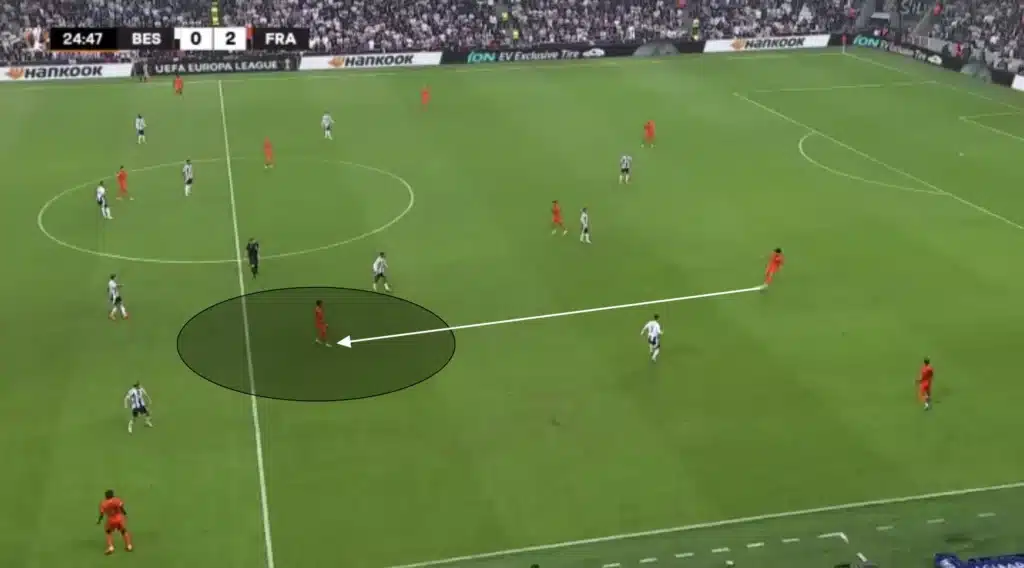
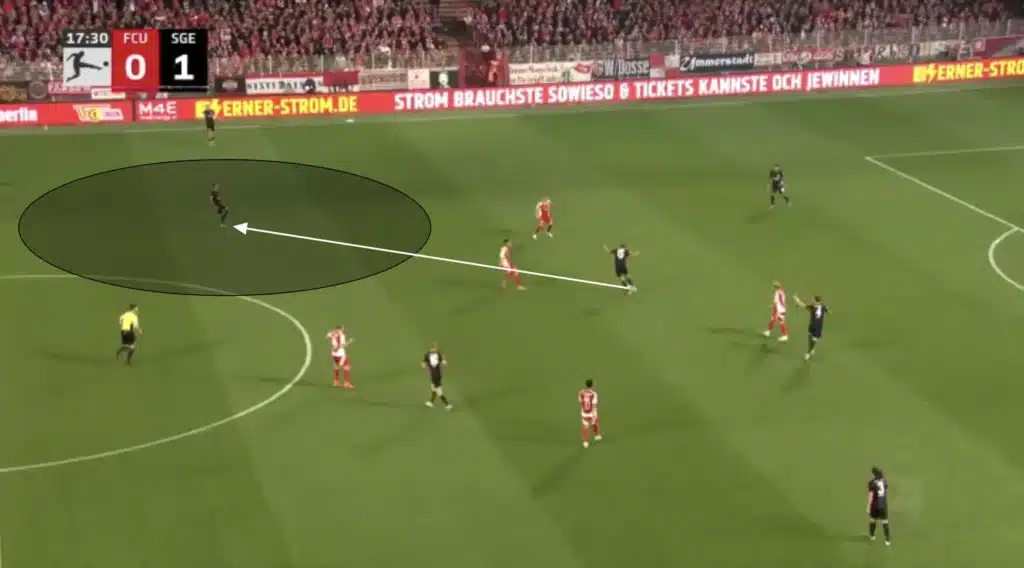
Finding these pockets is crucial for maintaining fluidity in attack and ensuring that the team can progress the ball effectively through the middle of the pitch.
Dropping Outside
When the opposition defends very compactly and does not allow the attackers to be found in the pockets, Frankfurt’s attackers can drop outside to receive the ball there instead. They will wait for the opposition’s wide midfielders to come into the middle and drop out into the space outside of him. The opposition center-backs and central midfielders rarely follow these runs, not wanting to open the space in the center. Additionally, the winger will be pinning the opposition fullback, not allowing him to jump on the dropping attacker. This means the Frankfurt attacker can receive the ball in this space, turn, and progress the ball unopposed.
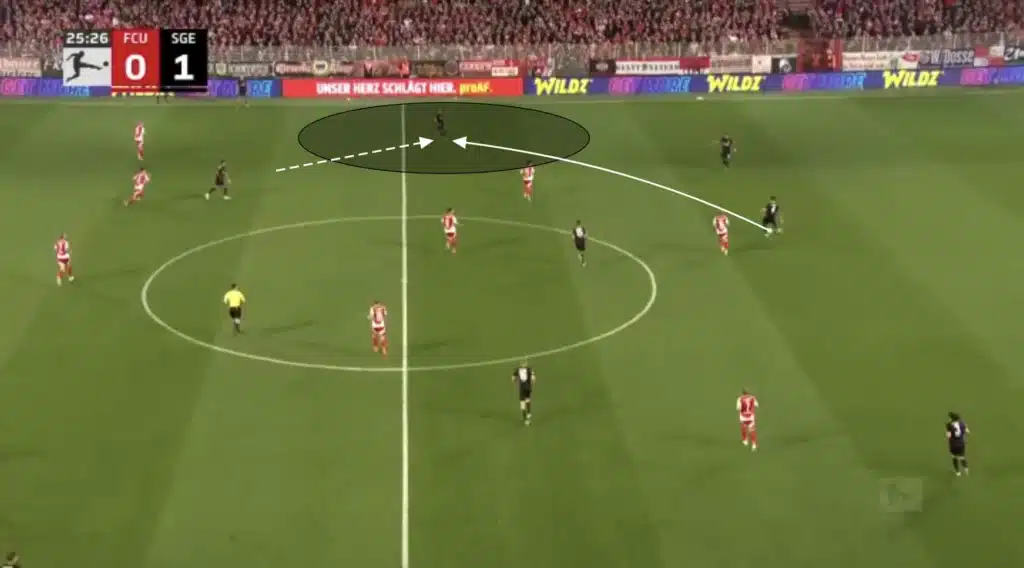
Attacking the Half-Space
Toppmöller’s players usually look to create chances by attacking the space between the opposition center-back and fullback. They primarily do this from the wide areas with underlaps from the attackers. When the winger receives the ball out wide he will attract the opposition fullback. This opens the space between the fullback and the center-back, which allows a Frankfurt attacker to make the underlapping run into this space. The ball can be played to the underlapping player, who can cross the ball into the box or attack his defender in a 1v1 situation.
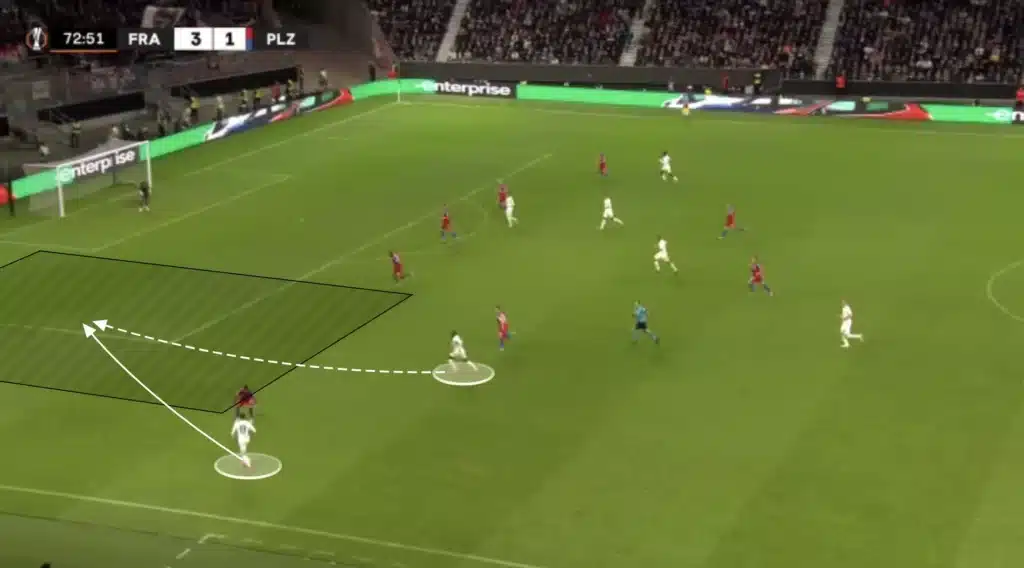
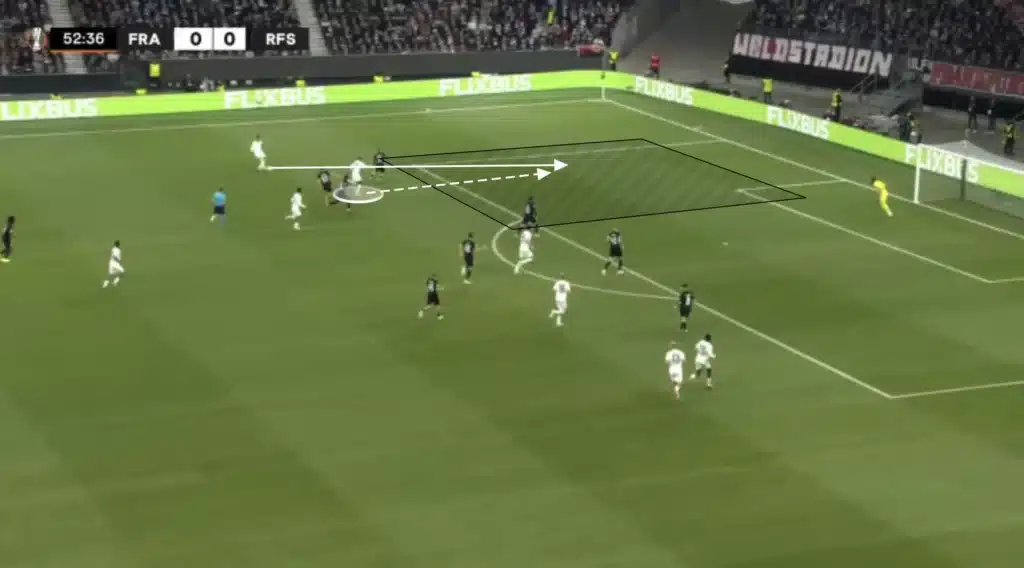
The winger does not have to play the ball to the underlapping player. The run from the Frankfurt attacker will often drag away an opposition defensive midfielder, which opens the space inside. The winger can take the ball inside and shoot or find a pass to a free player in front of the backline.
Defending
Eintracht Frankfurt’s base formation when defending is the 1-4-4-2 formation. They look to set up in a mid-block, always trying to close the center and force the opposition out wide.
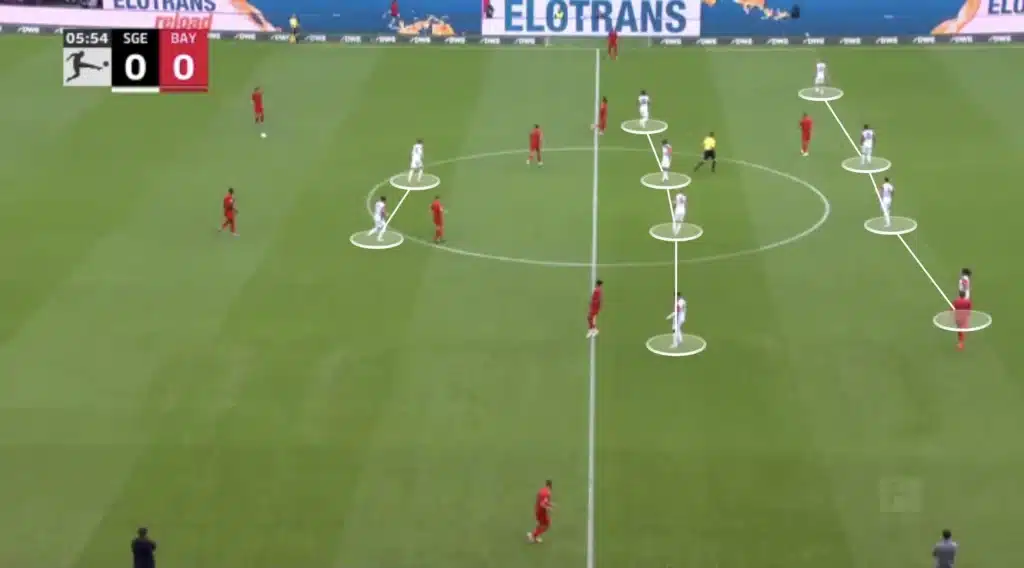
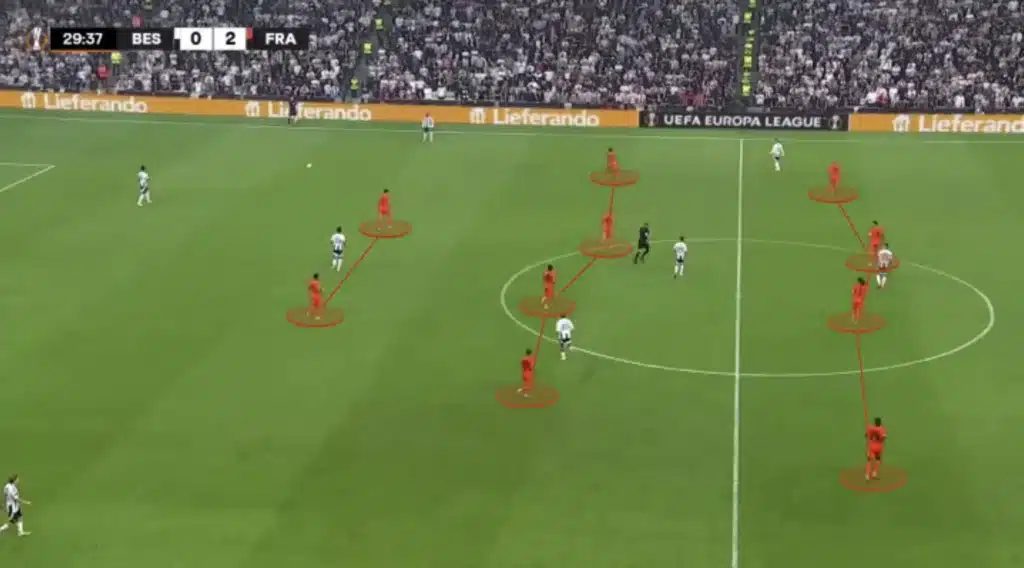
Defending in the 1-4-4-2 formation is all about balance, compactness, and discipline. The team defends in two compact lines of four, with the forwards positioned ahead of the midfield. The two forwards play a crucial role, not only as the first line of defense but also in initiating the team’s pressing strategy. Toppmöller wants his team to stay compact without dropping too low, preferably closing the space between the midfield and backline.
Frankfurt’s work rate when defending is exceptional, defined by relentless energy and discipline. Under Dino Toppmöller, the team is organized and compact, with every player contributing to defensive duties. The midfield and forward lines press with intensity, closing down spaces and forcing opponents into uncomfortable positions. Frankfurt’s backline remains focused, consistently tracking runs and maintaining their shape. When a defender breaks out of shape to put pressure on an opposition player, a Frankfurt midfielder will always drop into the backline to cover for his teammate.
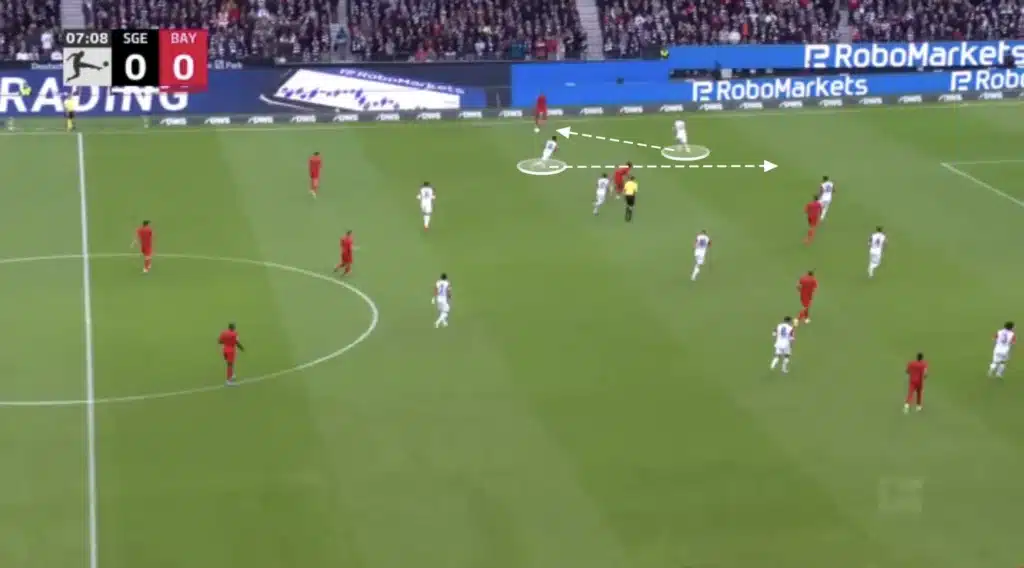

They will mainly do this to close the space between the center-back and the fullback. By having a wide midfielder step into these gaps, Frankfurt create a back five, allowing them to maintain their defensive shape, prevent overloads, and provide additional cover for their fullbacks, especially when they are pushed out wide.
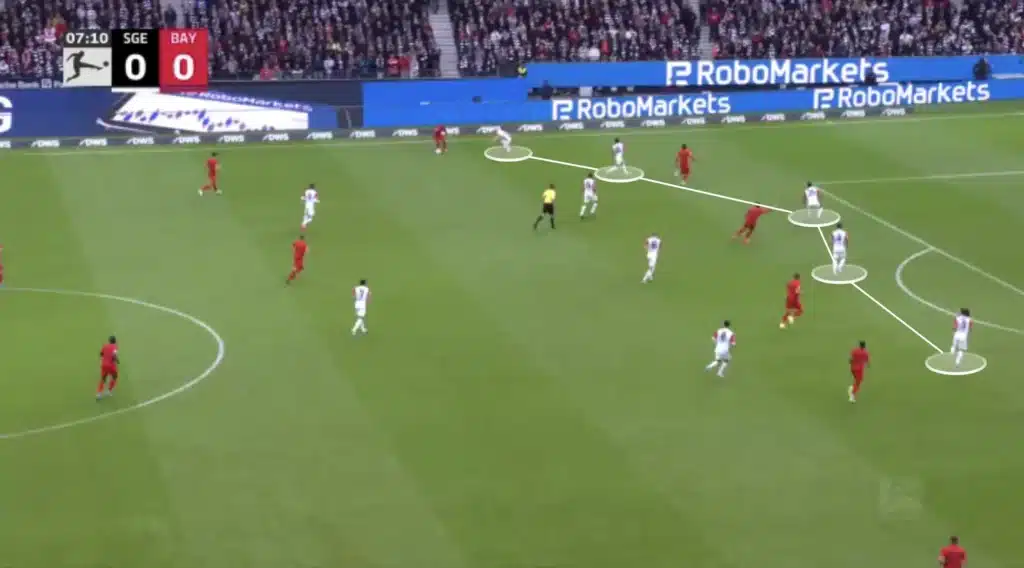
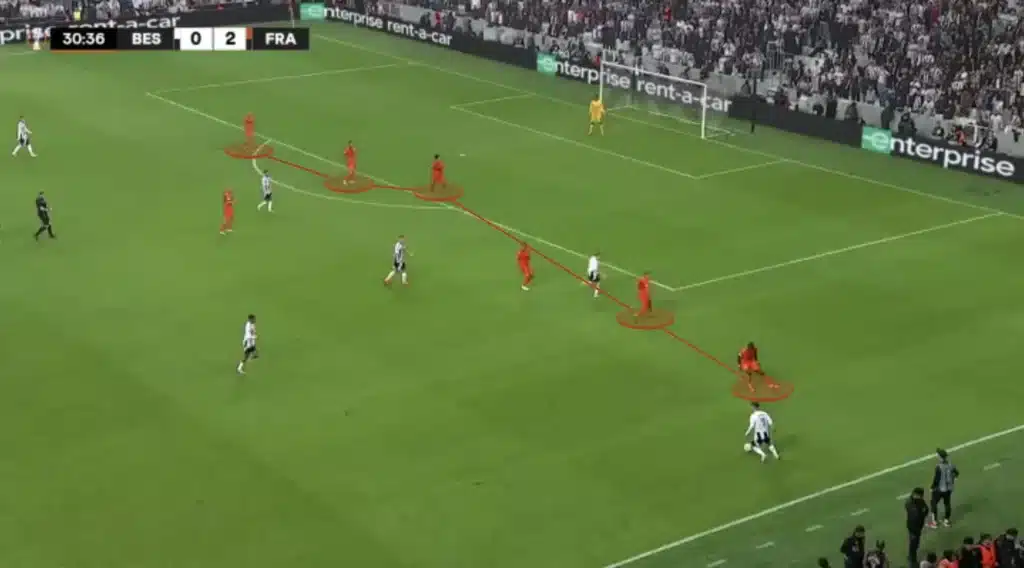
This compactness ensures that the team stays solid defensively, making it harder for the opposition to break through with wide or central attacks. Additionally, midfielders covering these spaces allow the center-backs to stay in the box in crossing situations.
Defending the Penalty Area
Eintracht Frankfurt’s approach to defending the penalty area under Dino Toppmöller often involves committing a large number of players—typically eight—to create a dense, layered defensive structure. By bringing players back, Frankfurt forms a compact low block that limits space for opposing attackers, making it challenging for them to find clear shooting angles or make penetrating passes. This setup includes two close lines, with midfielders dropping deep to support the defensive line, ensuring minimal gaps between defenders. The approach emphasizes blocking shooting lanes, crowding the box, and forcing opponents to rely on low-percentage shots from distance or wide areas, where Frankfurt can recover possession and quickly transition forward.
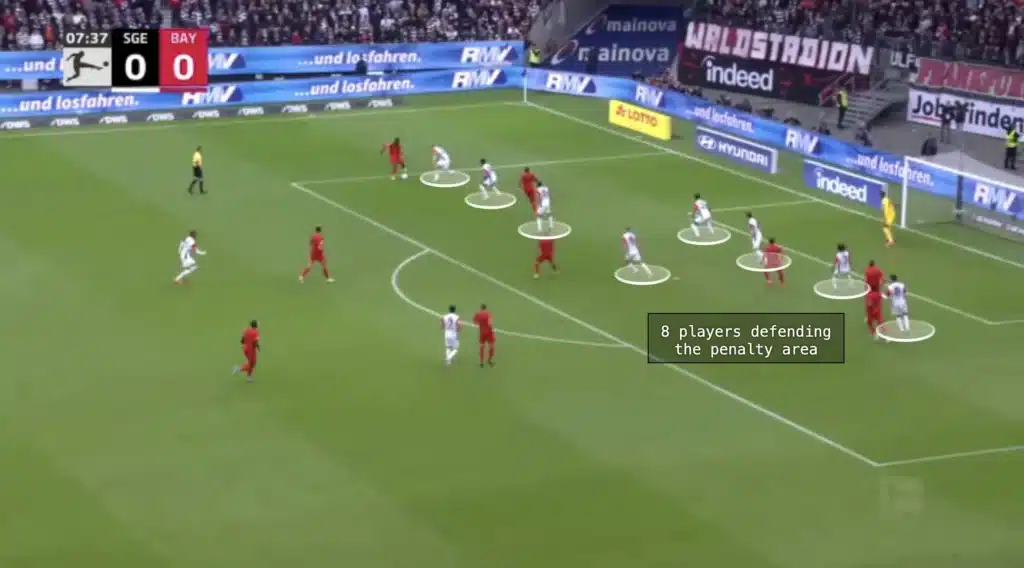
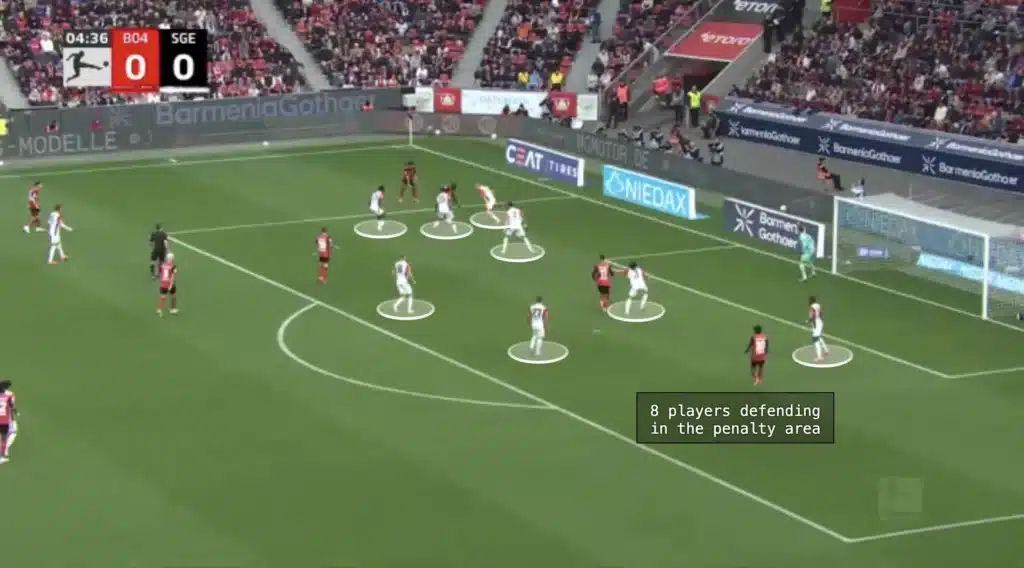
In addition to packing the box, Frankfurt adopts a man-to-man approach against opposition attackers inside the penalty area. Each defender marks their assigned opponent closely, preventing free movement and reducing the risk of unmarked shots or headers. This individual marking is particularly effective in dealing with crosses, as each Frankfurt defender shadows their player tightly, contesting every aerial ball and blocking runs that might create space.

By combining this man-to-man strategy with their compact structure, Frankfurt increases their defensive resilience, forcing attackers into physical duels and making it difficult for the opposition to break through.
Squeezing the Pitch
To prevent his team from becoming too low when defending, Toppmöller wants his team to squeeze the pitch. This means constantly pushing the team up as much as possible. Every time the opponent plays a slow, sideways pass or a back pass, Frankfurt’s first line of pressure pushes up, with the rest of the team following to stay compact. When the next pass comes, they push up even more, forcing the opponent back even more.
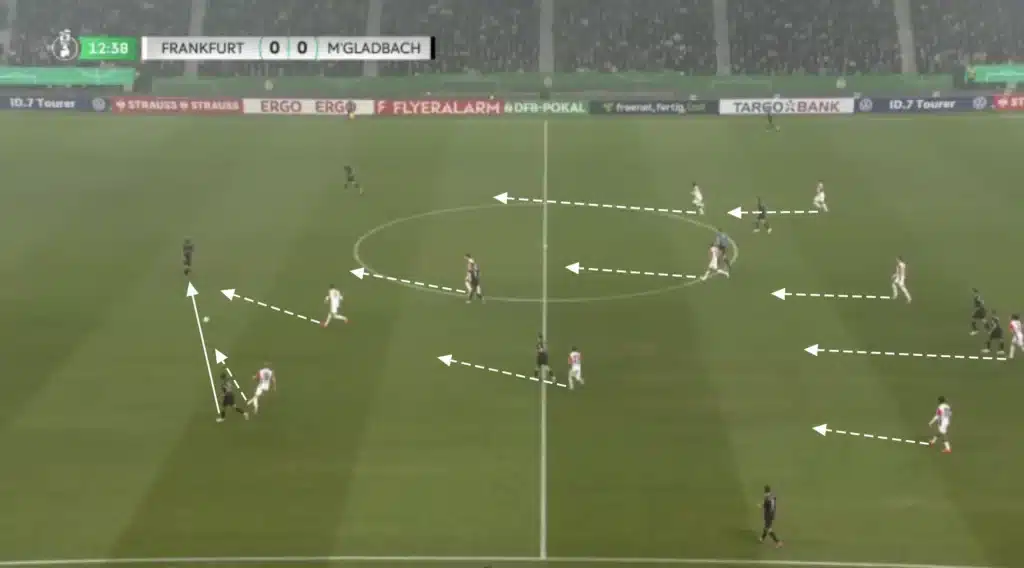
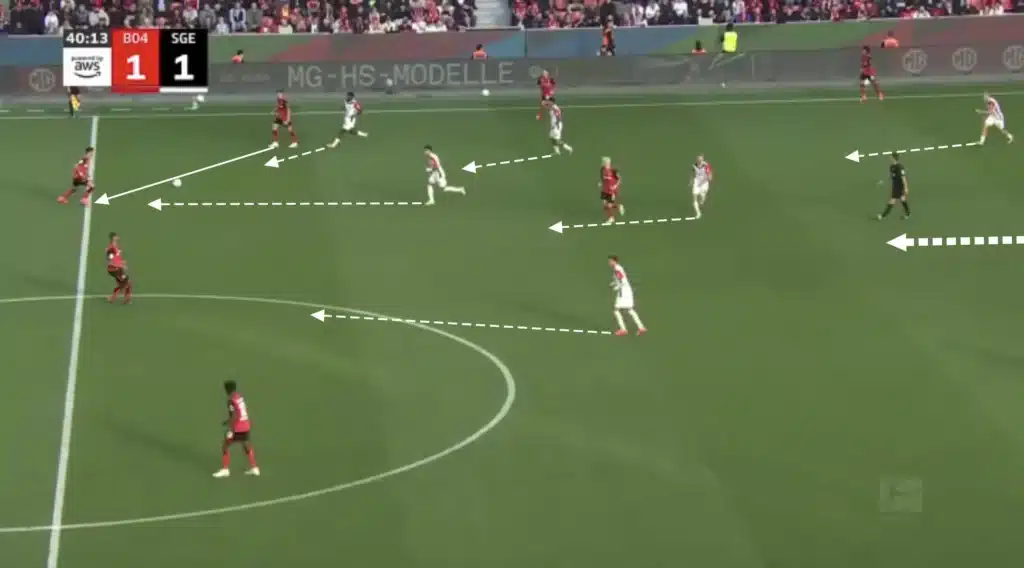
This approach keeps opponents under constant pressure, making it difficult for them to build rhythm or find space between the lines. It also pushes the opponent further away from Frankfurt’s goal, making it harder to create chances.
High Press
Toppmöller also wants to press the opposition high up the pitch. Their pressing structure will depend on the opposition, but they primarily press in their standard 1-4-4-2 formation.
When the play starts, the strikers will try to close off one opposition center-back by making angled pressing runs, forcing the opposition to one side. The rest of the players will shift across and try to win the ball by using the touchline as an extra defender.
When the opposition gets pushed out to one side, Frankfurt will be extremely aggressive and intensely press to win the ball. They will come across with many players, creating numerical superiorities around the ball, limiting the options for the ball-carrier, often resulting in a long ball and loss of possession.
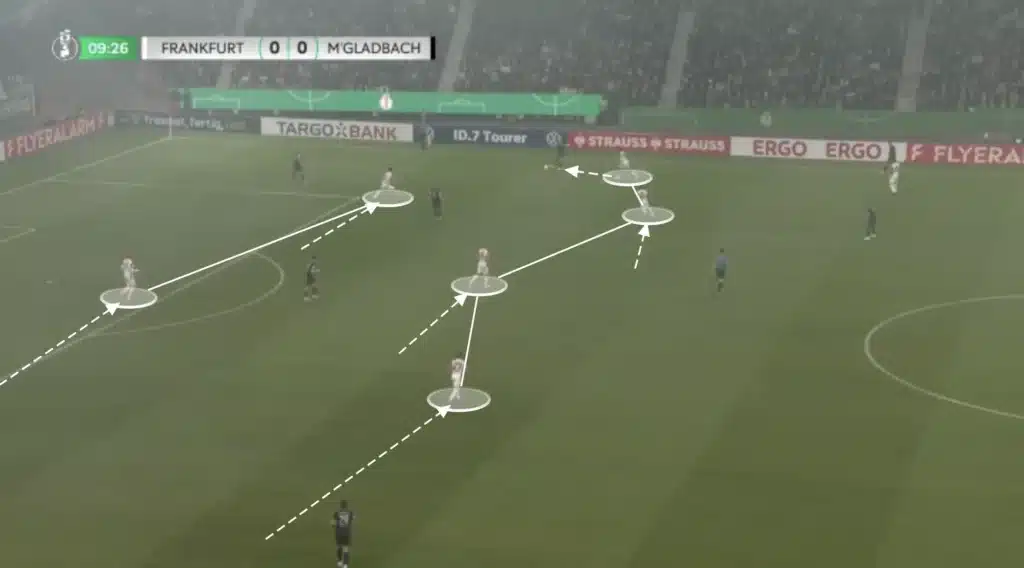
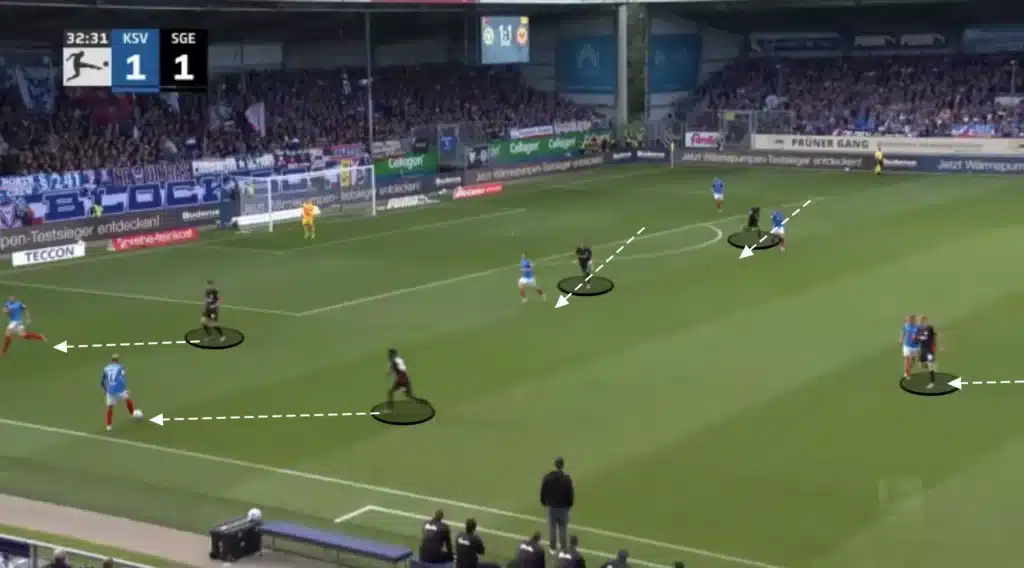
The benefit of Frankfurt’s pressing system is that it usually gives them a numerical advantage against the opposition attackers, which gives them more control when defending long balls.
Defensive Transitions
Frankfurt are also great in defensive transitions. In possession, they always have many players high up and close to the ball, which creates good conditions for counterpressing. Many players close to the ball after losing possession means that many players can work towards regaining possession. Toppmöller’s players are also very aggressive in the first seconds after losing the ball. The four or five players closest will immediately jump on the opposition player with the ball and close the distance to cut off any passing lanes. This approach disrupts the opponent’s transition from defense to attack, forcing errors and creating opportunities to regain control in dangerous areas.
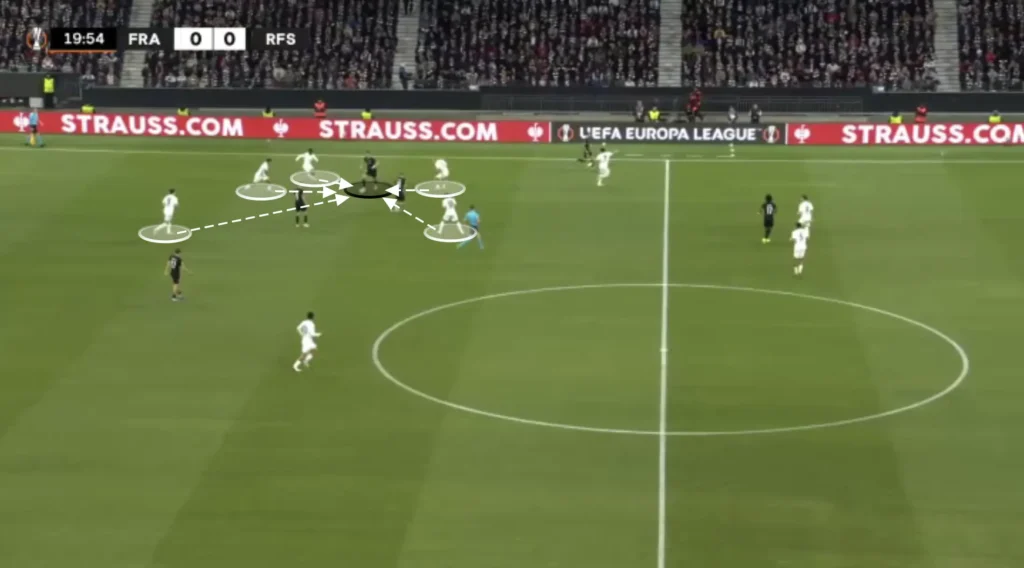
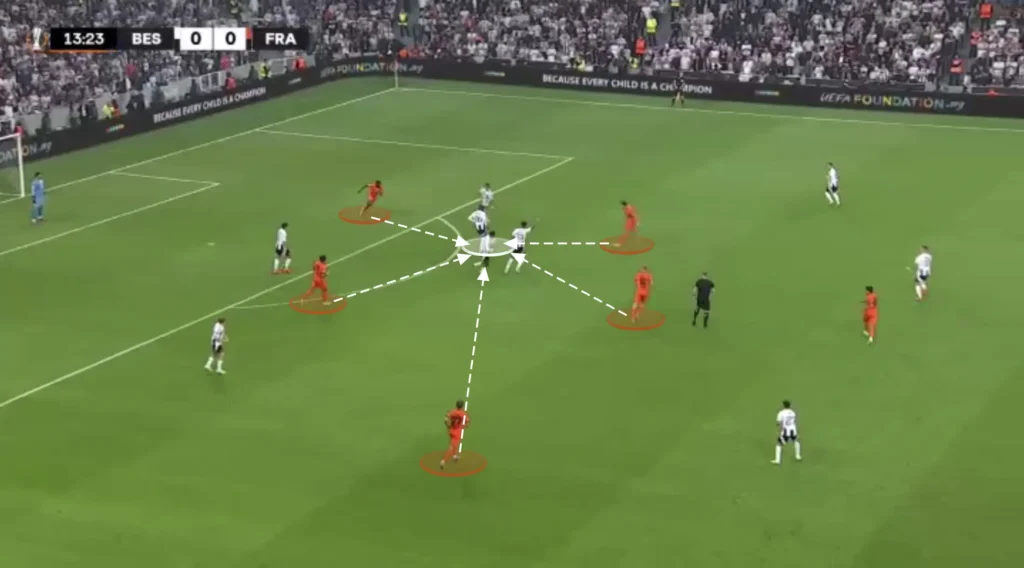
Counterpressing like this keeps Frankfurt on the front foot, allowing them to dominate possession and create more scoring opportunities. However, it requires exceptional fitness, tactical discipline, and teamwork.
Final Thoughts
In conclusion, Dino Toppmöller’s tactical approach with Eintracht Frankfurt reveals a thoughtful blend of discipline and offensive creativity. His strategy builds on compact defensive structures and quick transitions, allowing Frankfurt to excel both in control and counterattacking play. The balance he strikes between pressing intensity and structured build-up play has reshaped the team’s dynamics, making them versatile and unpredictable on the field.
Toppmöller’s tactics highlight his understanding of the game’s modern demands while staying true to Frankfurt’s strengths. As his tactical vision continues to develop, Eintracht Frankfurt fans can expect a blend of calculated strategy and intense gameplay that promises to keep opponents on their toes.
